Light Therapy and Hypothyroidism
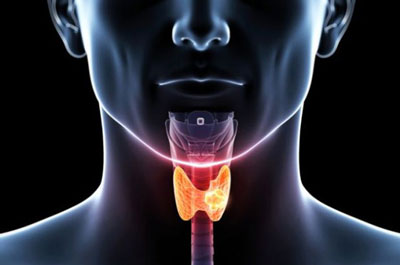
Medical & Healthcare Disclaimer
The information contained in this article is not intended or implicitly suggested to be an alternative for professional diagnoses, or profesionally recommended treatments & medical advice. Absolutely all of the content, including the article text itself, images, comments and other information, contained on this web page is for non-specific information purposes only. We strongly suggest that one should never ignore professional health/medical advice and we strongly suggest that one must not delay seeking a professionally recommended medical treatment because of information attained via reading this article/website. The products sold or recommended on this web site are absolutely not for the diagnosis, prevention, monitoring, treatment or alleviation of any specific disease, injury or disability.
Introduction
Light therapy potentially of aid to low thyroid people?
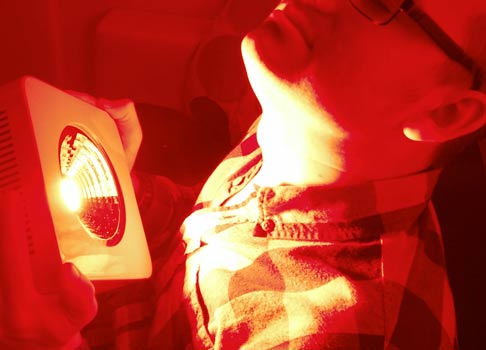
Light therapy directly on the neck is highly effective for thyroid treatment
- Some studies conclude that applying red light appropriately may improve production of the hormones. (Höfling et al., 2010,2012,2013. Azevedo LH et al., 2005. Вера Александровна, 2010. Gopkalova, I. 2010.) Like any tissue in the body, the thyroid gland requires energy to perform all of its functions. As thyroid hormone is a key component in stimulating energy production, you can see how a lack of it in the gland’s cells decreases further thyroid hormone production – a classic vicious cycle. Low thyroid -> low energy -> low thyroid -> etc.
- Light therapy when applied appropriately on the neck may potentially break this vicious cycle, in theory by improving local energy availability, thus increasing natural thyroid hormone production by the gland again. With a healthy thyroid gland restored, a host of positive downstream effects occur, as the entire body finally gets the energy it needs (Mendis-Handagama SM, 2005. Rajender S, 2011). Steroid hormone (testosterone, progesterone, etc.) synthesis picks up again – mood, libido and vitality are enhanced, body temperature increases and basically all symptoms of a low metabolism are reversed (Amy Warner et al., 2013) – even physical appearance and sexual attractiveness increases.
- Alongside potential systemic benefits from thyroid exposure, applying light anywhere on the body may also give systemic effects, via the blood (Ihsan FR, 2005. Rodrigo SM et al., 2009. Leal Junior EC et al., 2010). Although red blood cells have no mitochondria; blood platelets, white blood cells and other types of cells present in the blood do contain mitochondria. This alone is being studied to see how and why it may lower inflammation and cortisol levels – a stress hormone that prevents T4 -> T3 activation (Albertini et al., 2007).
- If one were to apply red light to specific areas of the body (such as the brain, skin, testes, wounds, etc.), some researchers hypothesise that it could perhaps give a more intense local boost. This is best shown by studies of light therapy on skin disorders, wounds and infections, where in various studies the healing time is potentially reduced by red or infrared light (J. Ty Hopkins et al., 2004. Avci et al., 2013, Mao HS, 2012. Percival SL, 2015. da Silva JP, 2010. Gupta A, 2014. Güngörmüş M, 2009). The local effect of light would seem to potentially be different yet complementary to the natural function of thyroid hormone.
Symptoms of low metabolic rate/hypothyroidism
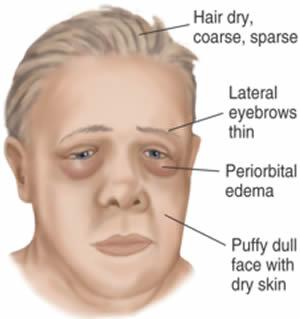
- * Low heart rate (below 75 bpm)
- * Low body temperature, less than 98°F/36.7°C
- * Always feel cold (esp. hands and feet)
- * Dry skin anywhere on body
- * Moody / angry thoughts
- * Feeling of stress / anxiety
- * Brain fog, headaches
- * Slow growing hair/fingernails
- * Bowel issues (constipation, crohns, IBS, SIBO, bloating, heartburn, etc.)
- * Frequent urination
- * Low/no libido (and/or weak erections / poor vaginal lubrication)
- * Yeast/candida susceptibility
- * Inconsistent menstrual cycle, heavy, painful
- * Infertility
- * Rapidly thinning/receding hair. Thinning eyebrows
- * Bad sleep
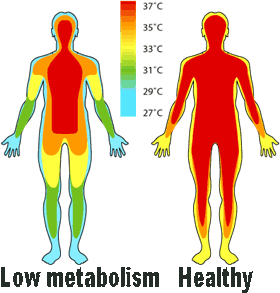
How does the thyroid system work?
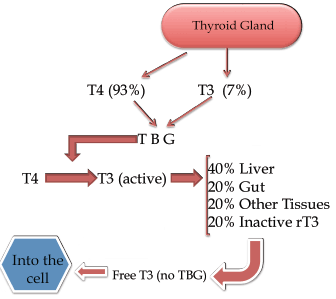
- The thyroid gland itself could not be producing enough hormones. This could be down to; a lack of iodine in the diet, an excess of polyunsaturated fatty acids (PUFA) or goitrogens in the diet, previous thyroid surgery, the so-called ‘autoimmune’ condition Hashimoto’s, etc.
- The liver could not be ‘activating’ the hormones (T4 -> T3), due to a lack of glucose/glycogen, an excess of cortisol, liver damage from obesity, alcohol, drugs and infections, iron overload, etc.
- Cells may not be absorbing the available hormones. Cells’ absorption of active thyroid hormone is usually down to dietary factors. Polyunsaturated fats from the diet (or from stored fats being released during weight loss) actually block thyroid hormone from entering cells. Glucose, or sugars in general (fructose, sucrose, lactose, glycogen, etc.), are essential for both absorption and usage of active thyroid hormone by cells.
Thyroid hormone in the cell
Assuming no impediment exists for thyroid hormone production, and it can reach cells, it acts directly and indirectly on the process of respiration in cells – leading to the complete oxidation of glucose (into carbon dioxide). Without sufficient thyroid hormone to ‘uncouple’ the mitochondrial proteins, the respiration process cannot complete and usually results in lactic acid rather than the end product of carbon dioxide.
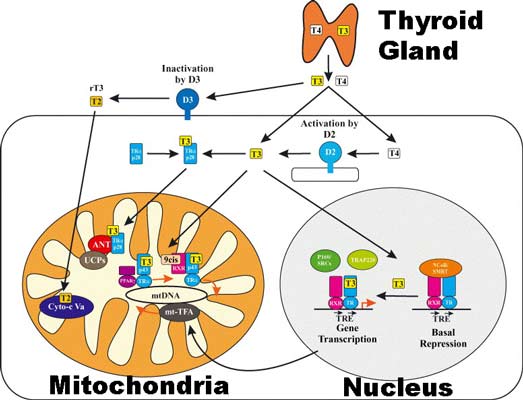
Thyroid hormone has complex interactions inside cells
Thyroid hormone acts on both the mitochondria and nucleus of cells, causing short term and long term effects that improve oxidative metabolism. In the nucleus, T3 is thought to influence expression of certain genes, leading to mitochondriogenesis, meaning more/new mitochondria. On the mitochondria that already exist, it exerts a direct energy improving effect via cytochrome oxidase, as well as uncoupling respiration from ATP production. This means that glucose can be pushed down the respiration pathway without necessarily having to produce ATP. While this may seem wasteful, it increases the amount of beneficial carbon dioxide, and stops glucose being stockpiled as lactic acid. This can be seen more closely in diabetics, who frequently get high levels of lactic acid leading to a state called lactic acidosis. Many hypothyroid people even produce significant lactic acid at rest. Thyroid hormone plays a direct role in alleviating this harmful state. Thyroid hormone has another function in the body, combining with vitamin A and cholesterol to form pregnenolone – the precursor to all steroid hormones. This means that low thyroid levels inevitably result in low levels of progesterone, testosterone, etc. Low levels of bile salts will also occur, thereby hampering digestion. Thyroid hormone is perhaps the most important hormone in the body, supposedly regulating all essential functions and feelings of wellbeing.Summary
* Thyroid hormone is considered by some to be the body’s ‘master hormone’ and production relies mainly on the thyroid gland and liver. * Active thyroid hormone stimulates mitochondrial energy production, formation of more mitochondria, and steroid hormones.- * Hypothyroidism is a state of low cellular energy with many symptoms.
- * Low carb diets and high PUFA content in the diet are prime offenders, along with stress.
Thyroid light therapy?
- * Infrared LEDs/lasers in the 700-910nm range.
- * 100mW/cm² or better power density
Bottom Line
* Red or infrared light from an LED source (600-950nm) is studied for the thyroid.- * Thyroid hormone levels are looked at and measured in every study.
